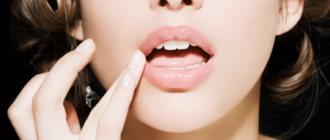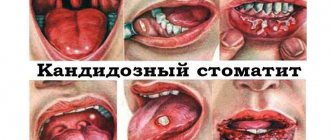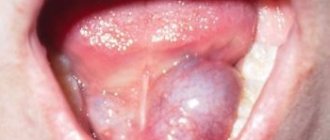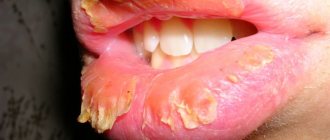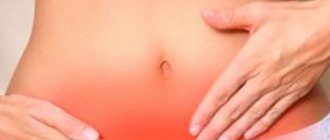Etiology [causes]
If burning lips occur, the causes of the unpleasant sensation may be:
- Adverse weather conditions. Due to strong winds, lips may become chapped;
- Sunburn;
- Lack of vitamins;
- Mechanical damage to the surface and inside of the lips;
- Stressful situations can lead not only to problems with the nervous system, but also contribute to damage to small blood vessels on the lips;
- The adverse effects of chapstick or toothpaste on delicate skin can lead to red spots appearing on the lips;
- Menopause in women. During this period, cracks may appear on this part of the face if a woman’s estrogen levels have decreased;
- Insufficient production of saliva in the mouth. Due to this condition, lips dry out and begin to crack;
- Herpes, which causes a pimple to appear on the lip.
This disease is also called a cold on the lip. If herpes hurts on the lip, then a person may have a fever, chills, and pain in the muscles and joints; - Hypothermia. In this condition, a person's lips begin to turn blue.
One of the common lip diseases is cheilitis, which can be both a harbinger and an accompanying disease. Cheilitis comes in several types.
If cracks (jams) appear in the corners of the oral cavity, such formations are a symptom of angular cheilitis on the lips
. With this condition, a person’s lips crack, it hurts him to speak, eat and smile, since the wounds on the lips cause pain and bleed. The causes may be:
- Iron-deficiency anemia;
- Riboflavin deficiency;
- Habit of thumb sucking. This habit is most often observed in young patients;
- Plummer–Vinson syndrome. With this pathology, the tissues of the oral cavity, throat, intestines and esophagus atrophy;
- An infection caused by germs. With this disease, a white spot forms on the inside of the lip;
- Weakened immunity;
- Dentures do not fit;
- Diabetes mellitus of the second degree;
- Poor oral hygiene;
- Feeling of dryness in the mouth.
With plasma cell cheilitis, inflammation of the lower lip is observed
. In this case, plaques form on this part of the face. With severe swelling, the soft tissues of the lips may become covered with yellow or brown crusts. If the patient notices such symptoms, then it is necessary to seek medical help as soon as possible. Since such formations may indicate the occurrence of a dangerous cancer disease.
If there is severe salivation, due to which the lips become dry and begin to crack after drying, then most likely glandular cheilitis has begun to develop.
. The disease usually occurs in the following situations:
- When a person smokes a lot;
- The patient is exposed to sunlight for a long time;
- There is a tendency to have an allergic reaction;
- An infection has entered the body.
Eczematous cheilitis
refers to diseases that occur due to contact of the surface of the lips with a substance that leads to an allergic reaction. The disease most often develops in women or young patients. The reasons may be the following factors:
- Interaction of the human body with allergens, which can be food, cosmetics, pollen, dental paste;
- Diseases of the endocrine system;
- Lack of vitamins in the body;
- Heredity;
- Wounds in which bacteria settle.
When a person is outside for a long time or exposed to the sun, he may develop actinic cheilitis. The disease most often occurs in young patients or men.
If the skin is too sensitive to external irritants (low air temperatures, sun rays, wind), then the lips become chapped, become red and inflamed. Painful ulcers appear on the surface, which can later become benign tumors.
Women are most susceptible to exfoliative cheilitis. With this disease, the lip contour suffers, which swells and causes pain. In addition to such symptoms, peeling and swelling appear in the lip area. Factors causing exfoliative cheilitis are disorders of the nervous system, increased anxiety, and hyperfunction of the thyroid gland.
Types of lip diseases
Diseases of various etiologies on the lips have similar symptoms. The doctor's task is to make the correct diagnosis. There are significant differences in patient management methods.
- Pigmentation above the upper lip: causes and treatment
- Treatment methods for papillomas on the oral mucosa
- Monroe piercing: how to do it, contraindications, care
Types of diseases:
- Cheilitis is a lesion of the red edge of the lip. Without proper treatment, the inflammatory process spreads to the oral mucosa. There are:
- Meteoric form.
- Allergic.
- Glandular variety.
- Atopic form.
- Jams.
- Cheilitis Manganotti is a precancerous condition.
- Chronic cracked lip.
- Fordyce granules are benign cysts in the ducts of the sebaceous glands.
- Herpes is a viral disease.
- Lip cancer.
- Stomatitis of various etiologies.
Internal manifestations
Diseases have external (visible) and internal (imperceptible to the eye) signs.
Symptoms of diseases.
| Diseases | Internal signs |
| Injury | Damage to the tongue, gums, teeth. |
| Exfoliative cheilitis | 80% of patients have hyperfunction of the thyroid gland. |
| Meteorological cheilitis | Often the patient suffers from neurodermatitis, seborrhea, and ichthyosis. |
| Glandular cheilitis | Patients with lupus, leukoplakia, and periodontal disease are at risk. |
| Allergic and atopic cheitlit | A blood test may show elevated levels of eosinophils. |
| Seizures | Infection with streptococcus or fungus of the genus Candida, vitamin deficiency. |
| Actinic form | A blood test may show elevated levels of eosinophils. |
| Heilith Manganotti | Hypovitaminosis, the presence of the herpes virus in the body, diseases of the gastrointestinal tract. |
| Chronic fissure | Lack of vitamins A, B2, B6. |
| Fordyce granules | Hormonal imbalance, promoting hyperproduction of sebaceous gland secretions. |
| Herpes | Presence of virus in nervous tissue. |
| Cancer | Metastases at stage 1. The route of transmission is lymphogenous, rarely - secondary tumors in the lungs. |
The diseases do not have characteristic symptoms indicating damage to internal organs. Diagnosis should be based on clinical examination.
External
External manifestations of sores have similar symptoms. Each has characteristics that help establish the correct diagnosis.
External manifestations
| Diseases | External symptoms |
| Exfoliative cheilitis | The scales are attached to the middle of the mouth. Peeling, pain. |
| Meteorological cheilitis | Dryness, tightness of the skin, formation of scales on the lower lip. |
| Glandular cheilitis | Swollen lips, peeling, cracks, secretion of drops of saliva and sticky mucus. The skin is constantly dry. |
| Allergic and atopic cheitlit | Peeling, erythrema, itching. |
| Seizures | Longitudinal cracks on the outside. Painful and bleeding. |
| Actinic form | The lower part of the mouth is affected. White scales are observed along the red line. |
| Heilith Manganotti | Erosion, but no more than 3 at a time. The ulcers may turn red, but do not bleed and have a smooth surface. |
| Chronic fissure | It is located horizontally in the middle of the lip. Small wounds may heal overnight and crack in the morning. |
| Fordyce granules | They are painless when pressed. They appear at the exit points of the sebaceous gland ducts. |
| Herpes | The mouth begins to itch and after a while a vesicle filled with liquid forms. |
| Cancer | On the outside there is a bulge with an ulcer in the center. Covered with a film, under which there are lumpy growths. May spread to gums, jaw tissue. |
Diagnostics
Specialists in the following areas will help determine the reason why your lips hurt: dentist, dermatologist, allergist and cosmetologist. The doctor will examine the patient and clarify the cause and location of the discomfort. The patient will be required to undergo the following types of laboratory tests:
- General blood analysis;
- Genetic analysis;
- Allergen identification test.
Based on the results of the examination, the attending physician will tell you what methods, based on your medical history, can be used to cure discomfort on the lips.
Traditional treatment
Sea salt
This is an effective natural treatment for benign tumors such as mucous cyst. You need to prepare a warm solution and rinse your mouth, then spit it out.
Yogurt
In addition to providing the body with vitamins, you can use plain, additive-free yogurt to relieve discomfort in the mouth.
Castor oil
Castor oil soothes the burning sensation in the mouth from wounds. You need to apply a few drops of castor oil to the formations on the inside of the lower lip.
Tea tree oil
Mix ½ teaspoon of tea tree with 1 spoon of honey and apply the mixture on your lip with bumps overnight.
With the help of a dermatologist, you can determine the accuracy of the diagnosis and identify the causes of sores on the inner skin.
When your lip hurts on the inside, seeing a doctor is one of the surest steps in overcoming an unpleasant illness.
Every person has experienced the formation of blisters both inside the mouth and outside on the lips. The presence of the virus has been proven by scientists to be present in the body of most people. Penetration occurs mainly in childhood; depending on the immune system, the bacilli can be located in the nerve fibers and remain there quietly, without causing concern.
Special tools help organize the activation of bacteria:
- physiological structure, hormonal imbalance during adolescence, during pregnancy
- unsteady immune system in infancy
- decrease in protective functions when acute or chronic internal pathologies are present in the body
- presence of immunodeficiency diseases
- presence of dental diseases
- lack of a healthy lifestyle
- violation of proper diet
If a white bubble appears, if the lip hurts on the inside, the doctor will prescribe what to treat, but the patient should take this seriously, since close contact with other people threatens to infect them.
Treatment
If pain occurs on the lips, the following procedures may be prescribed:
- Cryotherapy;
- Laser treatment;
- Electrocurrent therapy. During this procedure, the glands responsible for the production of saliva are affected from the inside of the oral cavity;
- Immunostimulating treatment, which is aimed at increasing the defenses in the patient’s body.
Together with all procedures, the patient should use the following to improve their lips:
- Corticosteroids;
- Antimicrobial ointments. Such ointments are especially relevant when there is herpes on the lips;
- Creams that contain an antibiotic;
- Ointments with calcineurin inhibitors.
If discomfort on the lips occurs due to an allergic reaction, then the dermatologist, based on a laboratory test, will tell the patient which allergen is best not to come into contact with. When burning and inflammation on the lips bother a person due to problems with the oral cavity, it is imperative to rinse daily with furatsilin or chlorhexidine. These medications help destroy bacteria and relieve redness that occurs on the lip from the inside.
If a defect on the lip does not suit a person aesthetically, then a cosmetologist will help solve this problem. To carry out a health procedure, a specialist will need hyaluronic acid.
In advanced cases, hemangioma on the lip, which presents as a red swelling, will only be eliminated through surgery.
According to the physiological structure of a person, a person may have a short frenulum under the upper lip. This feature causes inconvenience when talking or eating. When your frenulum hurts and your lip is swollen, you should definitely consult a dentist. The attending physician will perform a dental procedure, after which the pain will go away and the oral cavity will be healthy again.
Treatment of lip diseases can be carried out at home using folk remedies. To carry out wellness activities, you can use aloe juice, in which a cotton pad is moistened and wiped on the outside of the lip, which is swollen. You can also use plantain juice as a basis for creating medicinal lotions, which will relieve inflammation, reduce pain and can cure a bitten lip.
If your lip is swollen and a white sore appears on it, then the sore spot can be treated with chamomile decoction. This medicinal plant has an antimicrobial effect.
To successfully carry out health procedures, you must adhere to the following recommendations:
- Carry out oral hygiene daily;
- Control saliva production;
- Take a course of pharmacy vitamin complexes;
- Eat properly;
- Get rid of bad habits (smoking, drinking alcohol, not licking or biting your lips);
- Drink enough water. If a person drinks about two liters of liquid during the day, his lips will not crack.
Possible diseases
If symptoms such as peeling, dryness, redness or soreness of the lips appear, the possibility of infectious diseases should be excluded. The formation of crusts, cracks or wounds is often caused by diseases such as stomatitis, herpes, and cheilitis. When you get stuck and have a cold, it can be painful to open your mouth, eat, and even laugh. All these diseases require treatment, antibiotics, and antiherpes drugs.
Stomatitis
If the lower lip hurts, inflammation and white sores appear on it, stomatitis is diagnosed. The infection affects the mucous membranes in the oral cavity, manifested by pain, burning, and inflammation. The reason is decreased immunity, poor hygiene, and metabolic disorders. You cannot delay treatment, as after 2-3 days painful white or gray sores appear, covered with a thin film.
It is necessary to consult a dentist, have the oral cavity treated, and remove plaque. Baths with chamomile, oak bark, and rinsing with antiseptic preparations help get rid of stomatitis.
Cheilitis
If the lip hurts inside, looks inflamed and swollen, primary or secondary cheilitis is diagnosed. It is characterized by inflammatory processes in the skin, the appearance of cracks and dried crusts. Doctors believe that the causes of the disease are decreased immunity, stress, exposure to cold, wind, and ultraviolet radiation. A crust and swelling appear on the red border, the patient feels pain and a strong burning sensation.
Treatment consists of applying a solution of boric acid, anti-inflammatory ointments, and taking multivitamins to strengthen the body.
Seizures
Seizures are a bacterial disease that causes inflammation and pain on the edges of the lips. Painful cracks and small ulcers with a dense crust appear in the corners. Patients complain of pain and difficulty eating. Sometimes the cause of seizures is allergies, the habit of licking oneself in the cold. If the disease is not treated, the cracks turn into ulcers with open pustules. The doctor prescribes antifungal and antibacterial ointments, drying antiseptics.
Avitaminosis
With vitamin deficiency, severe peeling of the lips, dryness and cracks appear. The reason is the body's lack of vitamins A, E, B, and weakened immunity. You can eliminate the problem by taking a course of multivitamins as recommended by your doctor. It is also recommended to eat orange fruits, liver, and nuts. Oil masks with liquid solutions of vitamins E and A help well.
Herpes
If the upper lip or lower lip hurts, and colorless blisters form over the entire surface, the cause is the herpes virus. It is diagnosed in 90% of the population, most often observed in a latent form. The virus awakens when immunity decreases, after a cold, stress, or overwork. Other factors in its manifestation include taking medications, hypothermia, and overheating in the sun.
Most often, blisters appear in the corners of the mouth, accompanied by itching, burning, and pain when eating salty foods. Herpes is treated with special medications, supplementing the course with vitamins.
Cold
Colds in the corners of the mouth appear after chapping or being in the cold for a long time. It is also caused by a previous cold or hypothermia. First, peeling begins with peeling of the skin, then cracks grow. In children, a cold is a consequence of a runny nose and impaired nasal breathing. You need to breathe through your nose, forget about the habit of licking your lips in the wind. Hygienic lipstick and rich cream will help protect the skin.
Cancer
In rare cases, the cause of deep cracks and tears is cancer of the upper or lower lip. Most often, the disease is diagnosed in heavy smokers. A noticeable swelling appears, pain and bleeding are noted. In 90% of cases, the disease is treatable with timely consultation with a doctor.
Prevention
To prevent lips from causing discomfort, it is first necessary to carry out prevention. After all, as you know, it is better to prevent a disease than to treat it for a long time. As preventive measures, a person must adhere to the following rules:
- Use sunscreens;
- Wear a hat in windy and sunny weather;
- Stick to a diet. You need to eat more chicken meat, eggs, fish, cheese, cabbage, sorrel, nuts and butter, which contain large amounts of vitamin E. In the case where a sore on the lip appears due to a fungal infection, it is recommended to stop eating sweets. products;
- During treatment, you should not rinse your mouth with antimicrobial balms.
If you follow these simple rules, your lips will always be healthy.
You need to take care of your lips not only when they are sore and chapped. It is advisable to pay attention to this part of the face every day. In order to prevent drying out, lips should be smeared with cream and drink plenty of water every day. If cracks or pimples have formed on the surface of the lips, a medical specialist will tell you how to treat these symptoms during your consultation. The doctor will be able to determine the cause of the painful condition and suggest the correct treatment.
Treatment and prevention
Every patient should know what to do if their lips hurt, peel and crack. Treatment is usually local and does not require hospital observation or surgical intervention. Prevention consists of maintaining oral hygiene, proper brushing of teeth, and using hygienic lipstick. It is also necessary to monitor the condition of your teeth and gums, visit the dentist regularly, and remove tartar.
Treatment includes the following procedures:
- use of wound healing creams, ointments;
- application of bactericidal balms, disinfectants;
- preparing homemade masks from sea buckthorn or olive oil, jojoba and tea tree oils;
- massage with a soft toothbrush to increase blood circulation;
- taking complex multivitamins;
- taking a course of antifungal and antiherpes drugs.
If you follow all the rules of care and prevention, in 3-4 days you can get rid of cracks on your lips, cure wounds, small cuts and pimples. It is necessary to carefully monitor the condition of the skin around the mouth, promptly treat rashes, seizures and colds. Timely consultation with a doctor will help eliminate the manifestations of stomatitis, herpes or cheilitis, and maintain the integrity of the skin.
Bibliography
When writing the article, the therapist used the following materials:
- Neurostomatology: neuroanatomy of the face, facial pain [Text]: textbook for students of dental and medical faculties / Federal State Budgetary Educational Institution of Higher Education "Samara State Medical University" of the Ministry of Health of the Russian Federation, compiled by Kalinin V. A. [et al.]. - Samara: Etching, 2017. - 58 p. ISBN 978-5-473-01138-8
- Classification of headaches, cranial neuralgia and facial pain and diagnostic criteria for the main types of headache: [Transl. from English] / Classification com. on headaches International. headache islands; [Scient. ed. and ed. preface A. A. Shutov]. - Perm: ALGOS-press, 1997. - 92 p. ISBN 5-88493-017-8: B. c.
- Korotkikh, Nikolai Grigorievich Clinic, diagnosis, treatment of facial pain / N. G. Korotkikh, I. N. Lesnikova. - Voronezh: New Look, 2008. - 128 p. ISBN 978-5-93737-037-2
- Batishcheva, Elena Ivanovna Facial and oral pain [Text]: educational manual / E. I. Batishcheva, A. A. Kopytov, A. V. Tsimbalistov; Ministry of Education and Science of the Russian Federation, Federal State Autonomous Educational Institution of Higher Education "Belgorod State National Research University". - Belgorod: National Research University "BelSU", 2020. - 61 p. ISBN 978-5-9571-2211-1
- Pain syndromes in neurological practice / ed. A. M. Veina. M.: MEDpress-inform, 2001. 368 p.
- Tovazhnyanskaya, E. L. Trigeminal neuralgia: modern aspects of complex therapy / E. L. Tovazhnyanskaya // International Neurological Journal. 2010. No. 3 (33). pp. 141–145.
- Stagnieva, Irina Veniaminovna Clinical manifestation and immunopathogenesis of facial pain in diseases of the nose and paranasal sinuses: abstract of thesis. ... Doctor of Medical Sciences: 01/14/03, 03/14/09 / Stagnieva Irina Veniaminovna; [Place of protection: St. Petersburg. scientific research Institute of Ear, Throat, Nose and Speech]. — Rostov-on-Don, 2020. — 50 p.
Removal of a cyst on the lip (retention), which doctor to contact, treatment without surgery
A cyst on the lip is a hard lump with fluid inside. It tends to quickly increase in size and cause significant discomfort to a person. If even a small bubble is detected, you should consult a doctor and begin surgical treatment.
General characteristics of the disease
In most cases, a neoplasm in the oral cavity appears on the lower lip and is called a “retention cyst” or “mucocele.”
The cyst appears due to blockage of the lumen of the salivary gland. The cause may be a minor wound in the mouth or inflammation.
The disease usually does not develop into cancer, but requires serious attention and a mandatory visit to the dentist.
Recovery after surgery
After surgery, the patient should treat the wound with a special antiseptic several times a day and carefully monitor the healing process. As a rule, the most painful days are the first days after surgery.
During this period, it is difficult for the patient to eat normally and even talk. It is recommended to limit active movement of the mouth, smoking and drinking alcohol for two days after surgery. To relieve severe swelling, you can apply a cold compress or ice.
Gradually, the discomfort will decrease, and complete recovery occurs in about a month. The duration of recovery depends entirely on the size of the removed cyst.
If the tumor was large enough, then the first time after the operation the patient may experience severe distortion of the lip and a feeling of numbness.
Therefore, in order to avoid complications, it is important to remove the cyst in the early stages of development.
Medicines in the postoperative period
It is impossible to treat a cyst without surgery at home. The use of any medications is only an addition to the surgical method of removing the cyst. Medicines are used to speed up recovery and prevent complications during general treatment.
For disinfection, the patient should treat the affected area with the following agents: Chlorhexidine, Hexicon, Miramistin. The procedure must be carried out several times a day, always after meals to avoid inflammatory processes.
The doctor may also prescribe healing ointments, for example, Fucidin or Gioksizon. They will have a healing effect and are recommended to be used after meals along with antiseptics.
Thus, a lip cyst is a pathology that tends to develop quickly and increase in size.
Its treatment occurs only through surgery, and the use of any medications will be only part of the rehabilitation therapy. To avoid serious consequences, it is recommended to remove the cyst in the first stages.
Swollen upper lip: main causes, treatment methods and first aid for swelling
A person’s appearance determines his psychological state and how comfortable a person will feel among other people.
An unexpected illness that occurs to the lip changes the appearance of a person. Swelling is a nuisance not only from an aesthetic point of view. As the inflamed tissues become swollen, they become denser, rigidity appears, and sensitivity is often impaired. Sometimes such processes become dangerous for a person, for his health and life. It is advisable to discuss the choice of treatment after identifying the cause of the pathology. What could a swollen upper lip indicate?
Common Causes
Swelling may go away on its own without any complications. But it can also be a signal of a violation of internal processes in the body and require medical intervention.
To understand what to do if an adult’s upper lip is swollen, you need to try to find the root cause of this reaction.
The process can be triggered by:
- allergy;
- inflammation;
- venereal pathology;
- infection or virus;
- oral disease;
- lack of hygiene;
- dental problem;
- lip biting.
The causes of swelling of the upper lip vary. Often additional symptoms appear that should be taken into account in order to quickly navigate the situation.
It is important to pay attention to:
- symmetry of swelling;
- swelling of the gums, tongue, nose and cheeks;
- sensitivity in the area of edema;
- itching, burning, intensity of pain.
Looking at different photos of a swollen upper lip, you will notice that they have significant differences.
Swelling of the lips and nose
The process is usually accompanied by pain at the site of swelling. The root cause of swelling may be a disease that appears as a result of complications of caries or dental trauma. Medical procedures can be the source of the problem.
Contacting an endodontist will help you understand the situation. To make an accurate diagnosis, you will need to do a number of procedures, including an x-ray.
For treatment, anti-inflammatory therapy and caries treatment are prescribed.
Trauma to the face can also cause swelling of the upper lip and nose. First aid and contacting a traumatologist are necessary in such circumstances.
Sudden swelling of the lip
Often such symptoms appear as a result of an allergic reaction. The swelling spreads quickly, accompanied by itching and burning.
Swelling, accompanied by pain, can also be a signal of some serious inflammatory processes.
Additional symptoms appear:
- increased body temperature;
- numbness;
- skin hyperemia.
Delaying treatment can lead to serious complications.
Swelling of the inner side of the upper lip
The source of the problem is most often viruses and infections. Treatment is usually prescribed with antiseptics, antibiotics and antivirals, as well as immunomodulators, which increase the body's defenses to fight the disease.
The source of swelling may be hidden in a complex and unpleasant disease - periostatitis. In pathology, the bone tissue of the periosteum and jaw are exposed to inflammation.
Swelling of the lips and cheeks
A picture of swelling of the cheeks and lips may appear against the background of gumboil. The disease develops due to inflammation of the tooth root. The danger is that the inflammation spreads quickly and covers increasingly larger areas. If the pathology is not treated, the purulent process can affect the brain.
Swelling of the lip with numbness
Loss of sensation and swelling may result from:
- frostbite, burns or chapping;
- allergic reaction;
- insect bites;
- neuritis of the facial nerve.
Continuously increasing swelling, salivation, itching, redness of the skin are symptoms of suspected allergies. With these symptoms, emergency medical care is necessary to prevent angioedema.
Swelling of the upper lip in a child
Parents often wonder why their child's upper lip is swollen.
Your baby's first teeth can be a cause for concern. Their appearance is often accompanied by swelling of the lips. There is nothing dangerous about this. But a doctor’s examination is necessary, because the body can react this way both with allergies and with stomatitis; the process of swelling can also begin as a result of injury.
The root causes of swelling may be problems that arise in the child’s gastrointestinal tract. In this situation, more serious examination and treatment cannot be avoided.
First aid
It is generally believed that lip swelling in adults and children is not a serious problem. But even with such a pathology, you should consult a doctor in time to exclude serious complications.
Self-medication is always fraught with consequences, but if you cannot immediately get medical advice, you can try to alleviate the condition:
A cooling compress should be applied to swelling resulting from injury or an insect bite.
If the integrity of the tissue is damaged on the outside or on the mucous membrane of the lip, the area should be treated with hydrogen peroxide or any other healing agent should be used.
An allergic reaction to an irritant requires removing the cause of the effect and taking an antihistamine.
If the cause of swelling is herpes, then it should be treated with special ointments.
Urgent seeking medical help is necessary if additional symptoms are present: dizziness, nausea, chills, and also if the swollen area becomes hard and hot.
Photo of a swollen upper lip
Help the project, share your review



